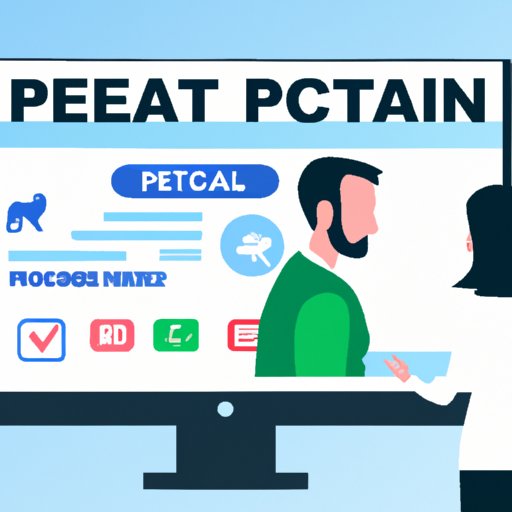
I. Introduction
PET scans are a critical diagnostic tool used to detect cancer, heart disease, and other medical conditions. The test provides detailed 3D images of the body’s internal organs and tissues, helping doctors diagnose and monitor disease progression. Unfortunately, the cost of a PET scan can be prohibitively expensive, making the test out of reach for many patients. In this article, we explore various options for getting a free PET scan, from clinical trials to financial assistance programs.
II. Option 1: Research Local Clinical Trials
Clinical trials are research studies in which people participate to test experimental treatments, medications, or diagnostic tests. As part of a clinical trial, participants may receive a free PET scan, which can be a significant cost savings. To find clinical trials in your area, start by searching online databases such as ClinicalTrials.gov, a registry and results database of publicly and privately supported clinical studies of human participants conducted around the world. Consider talking to your doctor for recommendations or checking a local university or research center’s website.
To be eligible for clinical trials, you must meet specific criteria, such as age, medical history, and current health status. Be sure to read the eligibility criteria carefully before applying. Many trials also offer compensation for participation, such as free transportation to the hospital or a stipend to cover time off work. Still, the study’s primary goal is to advance medical knowledge, not provide treatment, so there is no guarantee that you will receive a free PET scan as part of your participation.
III. Option 2: Apply for Financial Assistance
If you cannot afford a PET scan, many local hospitals and nonprofit organizations offer financial assistance programs to help with medical costs. You can search for such programs online or by contacting local hospitals and advocacy organizations. Many programs have strict eligibility criteria, such as income limits, residency requirements, or proof of insurance coverage. Be sure to review the program’s requirements carefully before applying.
When applying for financial assistance programs, make sure you have all the necessary documentation, such as proof of income, medical bills, and other expenses. Be prepared to explain your financial situation and why you need assistance. Some programs require a letter of recommendation from a doctor or social worker. Don’t be afraid to ask for help with the application process if you need it.
IV. Option 3: Utilize Patient Assistance Programs
Many pharmaceutical companies offer patient assistance programs to help offset the cost of their medications and diagnostic tests. You can search for such programs online or by contacting the drug company directly. Typically, these programs are available to patients with little or no insurance coverage, low income, or high out-of-pocket costs. However, eligibility requirements vary by program, so be sure to check the company’s website or call their customer service line for more information.
When applying for a patient assistance program, you will need to provide information about your medical condition, treatment plan, and financial situation. You may need to provide income tax returns or other financial information to prove your eligibility. Be prepared to fill out a lengthy application form, and expect the process to take several weeks or months.
V. Option 4: Check with Your Insurance Provider
If you have health insurance, check with your provider to see if your policy covers a PET scan. Insurance coverage for medical tests varies widely, so it’s essential to understand the details of your plan. You may need a referral from your primary care doctor, and you may need to use an in-network provider to receive coverage.
If your insurance policy does not cover a PET scan, consider shopping around for a new policy that does. Many states have health insurance exchanges that offer affordable coverage to low-income individuals or families. Be sure to weigh the monthly premium costs against the coverage benefits to determine if a new policy is worth considering.
VI. Option 5: Consider Crowdfunding
Crowdfunding is an increasingly popular way to raise money for medical expenses, particularly for those without insurance or with high out-of-pocket costs. Sites like GoFundMe, YouCaring, and GiveForward allow individuals to set up fundraising pages and ask for donations from family, friends, and even strangers.
While crowdfunding can be effective, it’s not a guaranteed solution. Many campaigns fail to reach their fundraising goals, and some people object to asking for financial help from others. Additionally, crowdfunding sites charge fees for their services, and donations may be taxable income for the recipient.
If you decide to pursue crowdfunding, be sure to promote your campaign widely on social media and other channels. Tell your story honestly and explain why a PET scan is critical for your health. Consider offering incentives, such as updates on your condition or thank-you notes for donors.
VII. Option 6: Talk to Your Doctor
Your doctor is one of your best resources for finding assistance with medical costs. They are knowledgeable about the healthcare system and may be aware of resources and programs you didn’t know existed. Be honest with your doctor about your financial situation and your need for a PET scan. They may be able to recommend a clinical trial, financial assistance program, or other resources that can help.
Additionally, building a good relationship with your doctor can benefit your overall health and wellbeing. Schedule regular appointments, ask questions, and take an active role in your treatment plan. Communicate openly and honestly, and be receptive to your doctor’s recommendations.
VIII. Conclusion
While PET scans can be costly, there are many options available for getting a free or low-cost scan. From participating in clinical trials to applying for financial assistance or patient assistance programs, there are resources available for those who cannot afford this essential diagnostic tool. It’s essential to explore all your options and talk to your doctor about finding the right solution for your unique situation. Seeking help is critical to getting the care you need, so don’t be afraid to ask for assistance.





